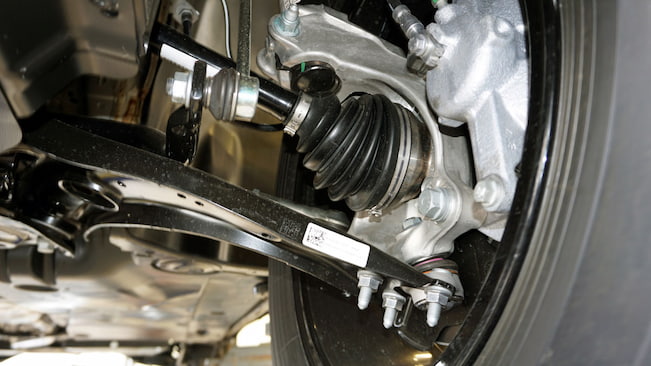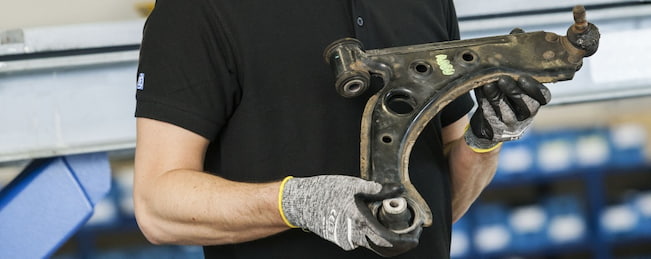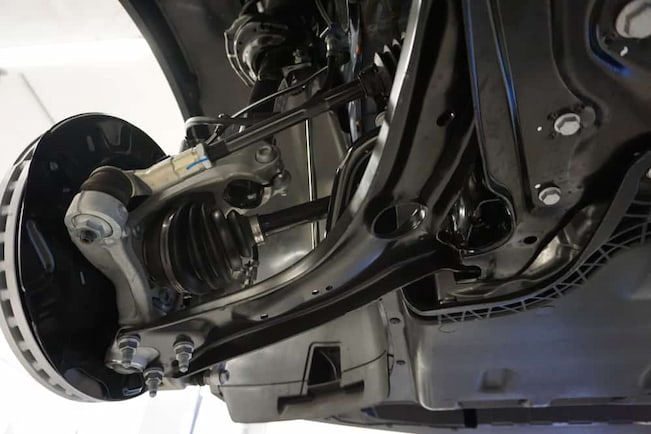Cars are complex feats of engineering consisting of thousands of different parts. Those that make up the suspension system are responsible for driver and passenger comfort by absorbing and dampening shocks from irregular road surfaces, maintaining safe vehicle height and stability, and providing optimal levels of handling and control.
The suspension is tasked to keep the tyres in contact with the road at all times, and ensure that the car can brake, turn, or accelerate when needed without overly emphasised body roll. Besides common parts like springs and shocks, almost all road-going cars also have suspension or control arms. These form the physical link between the wheels, suspension and chassis and serve several crucial functions.

What is a Suspension Arm?
Control or suspension arms are a vital component in any suspension system as they serve as the structural link between the car chassis and the wheels. One part of the link is bolted onto the chassis and allows for vertical movement, and the other is connected to the wheel assembly via a steering knuckle and ball joint to allow the car to steer left and right.
You’ll find a car suspension arm connecting both front wheels in most cars, but some trucks and heavier vehicles can additionally have a suspension arm at the rear axle. These are also used for additional bracing and enhanced control in performance cars. There are also differences in the shapes they take and the type and number of control arms depending on the vehicle’s suspension setup.
What Job Does it Do?
Control arms have several purposes. By connecting the wheels and the car frame they provide stability, They aid with dampening vibrations from wheel movement allowing for a smooth and comfy ride. They are also tasked to improve control and handling by maintaining constant contact of the wheels and tyres with the ground. This enhances traction, provides a better steering feel and keeps the planted regardless of how good or bad the road is. Damaged control arms not only hinder drivability, but can also pose a safety risk, so changing due in due time is a necessity.
Different setups and types of control arms additionally contribute to better performance. Some types allow the adjustment for camber (or the inward/outward tilt of the wheels in relation to the car), caster (how far forward or behind the steering axis is to the vertical axis, viewed from the side) and toe (or the angle of the wheel in relation to the car centerline when viewed from above).

What Types are There?
The design and type of control arms will vary across different types of suspension. The most common are the “A” shaped types in the form of a triangle, with the narrow end attaching to the wheel assembly via a ball joint and the broad end to the chassis with bushings. Some suspension arms assume an “L” shape and attach to the wheels and frame in a similar way. Another common type in terms of design are straight rods and these too use ball joints and bushings to connect the wheels and car frame.
“A” frame arms are most common in double wishbone suspensions, consisting of an upper and lower control arm. The complexity of the design means they offer better handling and control, and are most often found in performance cars and SUVs. There are more parts though and more things to go wrong, so maintenance here is key. Less complex but still capable are control arms used in MacPherson struts. These do away with the upper control arm, using a strut instead to support the weight of the car, so there’s less weight, fewer parts, lower costs and generally less maintenance. Choosing replacement suspension arms then will depend on your vehicle’s setup, and compatibility is one of the key points in choosing what’s right.
The Materials Used
If you considering upgrading, then have in mind that a suspension arm can be optioned in three basic materials – steel, aluminium and cast iron. Stamped steel has decent strength, good flexibility and low production costs and is a decent option as a replacement for different types of vehicles. The drawbacks are the heavier weight (which can negatively affect handling) and the low resistance to corrosion.
Cast aluminium variants are much lighter, so preferred in smaller and compact cars. They also have comparable strength and aren’t prone to rusting, but lack steel’s inherent flexibility. This can lead to cracks or bending.
Lastly, cast-iron control arms with high compressive strength feature in heavier vehicles, but have less flexibility. These are viable options for both steel and aluminium variants when looking for something that will last.

Common Suspension Arm Problems
Control arms can sustain different types of damage. While the main part of the suspension arm will hold its own against general wear and tear, rust buildup is a common issue in cars with more mileage and this deteriorates ride quality and controlling the car. The parts can also bend and crack when coming under higher forces such as in collisions, and hitting potholes at speed.
Other frequent issues are damaged bushings, leading to unusual grinding noises, low comfort levels and handling problems. Damage to arms with integrated ball joints often means that you’ll have to replace the whole assembly, so higher costs upfront. Symptoms that point to damage in these parts include excessive vibrations, a wandering steering wheel, grinding and clunking noises, an uncomfortable ride and the car pulling to either side. More acute damage will mean difficulty in braking and steering.
Choosing Replacements
When buying a replacement car suspension arm, look for respected brands that use high-quality materials (with anti-rust coatings), variants that are suited to the car and in the right design and purpose (upper vs lower control arms) and parts that fit your budget. Control arms and related suspension parts can be had as OE replacements, either from dealers or parts resellers, whereas anyone looking for a boost in handling and vehicle control should go aftermarket for the best deals.
























